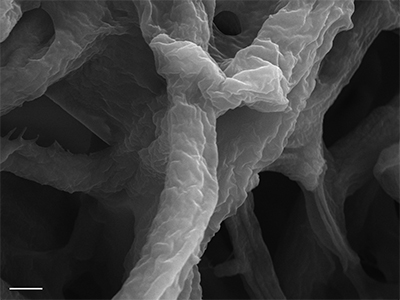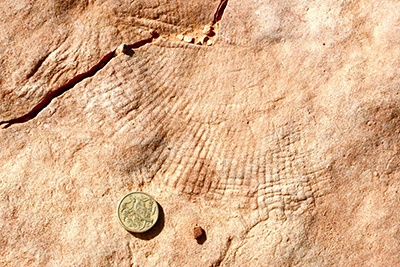Some of Earth’s best-preserved fossil bacteria occur in rocks from the Ediacaran period of geologic time, which runs from about 635 to 541 million years ago. Scientists don’t completely understand how these fragile bacteria became fossils. However, a new experimental study is now shedding more light.
Modern bacteria thought to be similar to Ediacaran bacteria can become coated in clay mineral shields, which protect the microbes against destruction. In the process, these shields give the bacteria a better chance of making it into the fossil record.
The planet’s oldest known animal fossils also appear during the Ediacaran period, and the bacteria on which the new study focuses could have played a key part in helping these creatures fossilize. Understanding how the bacteria became fossils might eventually increase our understanding of how the planet’s first animals made it into the rock record as well.
Encasing Bacteria
Researchers who study Ediacaran bacterial fossils have observed that they can be “coated in a fine layer of clay, which indicates that clays have some sort of important role in their preservation,” said Sharon Newman, a Ph.D. student at the Massachusetts Institute of Technology who led the recent study published in Geology. To explore what that role was, Newman and her colleagues focused on cyanobacteria, photosynthetic aquatic bacteria that can grow in colonies and that show up often as fossils in Ediacaran rocks.
The team grew cyanobacterial colonies in jars filled with artificial seawater and either beach sand or the clay mineral illite. The water chemistry mimicked the makeup of modern-day oceans but with one key difference: “The only thing I changed was the concentration of silica,” which is thought to have been higher in Ediacaran oceans than it is today, Newman said. “When we have higher levels of oceanic silica, you get a smoother, more extensive coating of these cyanobacterial cells,” she explained. After about 5 days growing on sand or illite, most cyanobacteria developed clay coatings.
Trapping Clay Coats
The team then wanted to know how, exactly, the coatings were forming. “We found that the cyanobacteria [become coated] in clay minerals via two mechanisms—trapping of particles as well as precipitation” of clay particles out of the water and onto microbial surfaces, Newman explained. When trapping takes place, suspended clay particles simply drift down through the water column until they land on the naturally “sticky, sticky surface” of each cyanobacterium, she said.
Trapping-produced coats formed when there was between 5.6 and 55.6 milligrams per liter of suspended clay, the experimenters found. Uncoated microbes, imaged using a Zeiss Supra scanning electron microscope, were about 1 micrometer thick, whereas coated microbes were about 1 to 1.5 micrometers thick.

The team also wanted to find out if clay mineral ions dissolved in the water could, in addition to trapping, precipitate onto bacterial surfaces. To address this, Newman said, the team had “the cool idea to use dialysis bags,” which are porous bags that allow only particles of a certain size in or out. “If you fill a dialysis bag with sand” and then let the cyanobacteria grow outside the bag, explained Newman, then trapping should not occur. “If any precipitation is happening, then certainly, the ions could pass through the dialysis bag,” she said.
About a month into the dialysis experiment, cyanobacteria contained only sparse grains of clay, indicating that trapping appears to “be the quicker, more predominant method, and it does a very nice job of completely coating cells,” Newman noted. “This is an explanation for why such exceptional microbial preservation occurs in the Ediacaran.”
Making Shields for Animals
Knowing how Ediacaran bacteria fossilized might one day help explain how the mostly soft-bodied Ediacaran biota, which includes Earth’s earliest animals, became fossils as well, suspects James Schiffbauer, a paleontologist at the University of Missouri in Columbia, who was not involved in the new research.
Paleontologists have previously proposed that colonies, or “mats,” of bacteria thought to have been common on Ediacaran seafloors blanketed Ediacaran animals after they died. If clay coated those bacterial mats, it may have also helped shield the animals’ bodies from destruction, Schiffbauer suggests.
That clay minerals might coat cyanobacteria is not a new idea, however, said Schiffbauer. “But this study provides really nice, tangible, observable evidence that it can work,” he said. Newman and her coauthors are “now showing how lithification of the bacterial mat can proceed.”
As Schiffbauer explains, clay-coated bacteria would have formed “molds” around dead Ediacaran animals and done so quickly enough to create a seal between each animal and its surroundings, halting or at least impeding bodily decay and destruction. Understanding exactly how clay-coated bacteria helped with the preservation of soft tissues, though, will have to await future laboratory experiments, he said.
Schiffbauer also noted that bacterial mats, expanding upon the seafloor, often formed odd-shaped sedimentary “textures,” which in rocks today can look like wrinkled elephant skin or coils of rope. He recalled that when he first learned about this new research at a presentation by Newman at a past meeting of the Geological Society of America, he had thought “it was a captivating study, one of those where I said ‘wow, this is really cool,’ because it has the potential to influence our understanding of how microbial textures may be captured.”

Extraordinary Ediacaran
Fossil preservation of microbes in this fashion is almost entirely unique to the Ediacaran period: for most of the rest of geologic time, from about 541 million years ago to the present day, microbial mats are mostly absent from fossil evidence of what was on ancient seafloors.
One reason such superb preservation came and went, Newman explained, is that soon after the Ediacaran period, animals that feed upon bacterial mats evolved and proliferated. Another reason is that the presumed relatively high concentrations of clay in the Ediacaran oceans declined soon afterward. Why did silica- and clay-rich waters become scarce? Scientists suspect that the evolution of silica-absorbing organisms, including diatoms and sponges, stripped the seas of most of the suspended silica they once contained.
Schiffbauer said that he would like to see further laboratory experiments trying to replicate microbial patterns like the ones responsible for such structures in the rock record. “You could artificially create ripple marks by moving directed water over the surface and then increase clay concentrations in the water to see if you can actually replicate the mineralization of the microbes” that grow upon the wavy surface, he suggested. “It’d be interesting to see if what they’re seeing on the individual microbe level is extrapolatable to bulk microbes.”
—Lucas Joel, Freelance Writer; e-mail: [email protected]
